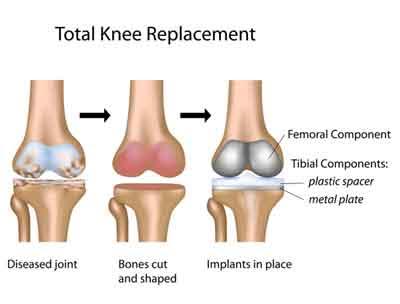- Home
- Editorial
- News
- Practice Guidelines
- Anesthesiology Guidelines
- Cancer Guidelines
- Cardiac Sciences Guidelines
- Critical Care Guidelines
- Dentistry Guidelines
- Dermatology Guidelines
- Diabetes and Endo Guidelines
- Diagnostics Guidelines
- ENT Guidelines
- Featured Practice Guidelines
- Gastroenterology Guidelines
- Geriatrics Guidelines
- Medicine Guidelines
- Nephrology Guidelines
- Neurosciences Guidelines
- Obs and Gynae Guidelines
- Ophthalmology Guidelines
- Orthopaedics Guidelines
- Paediatrics Guidelines
- Psychiatry Guidelines
- Pulmonology Guidelines
- Radiology Guidelines
- Surgery Guidelines
- Urology Guidelines
Understanding Total Knee Replacement Surgery

Total Knee Replacement Surgery (TKR) is the best surgical procedure to tackle end stage Arthritis of the knees. It is one of the most commonly done operations by orthopaedic surgeons worldwide. It has stood the test of time and technical advances continue to improve results.Every patient who suffers from Knee Joint Arthritis has at some time or the other, considered Total Knee Replacement. Some patients are put off by the very thought of undergoing what they think is a major operation and are often ill advised about the nature of this procedure. The purpose of this article is to try to clear some misconceptions and educate people about the newer trends in total knee arthroplasty surgery.
The knee joint surfaces (where the bones touch each other) are covered with cartilage which acts as a shock absorber and also reduces friction. Cartilage performs a function similar to the rubber on your car tyre; only it is alive and provides a much better low friction articulation. In patients of Arthritis this cartilage thins out or is completely lost. This can be viewed on X-ray as a loss of gap between the bone surfaces. The increased friction in the absence of cartilage generates debris, which sets off an inflammatory reaction. This causes pain, swelling, immobility and further joint destruction. Medicines and physiotherapy exercise cannot restore lost cartilage. No medicine can regenerate cartilage and bone. This does not mean that medicines have no role in the treatment regimen. They are important to reduce the pain and inflammation in the early stages of the disease. They allow the patient to carry on with exercises and joint mobility till the end stage is reached thereby keeping the muscles and ligaments healthy. It is very important to combine conservative measures of management with activity restriction. For example, in early cases with mild to moderate loss of cartilage, the patient may benefit from lifestyle modification by changing habits that cause more knee damage like sitting on the floor, stair climbing etc.
Total knee replacement (TKR) does not mean replacing the human knee with a machine. It simply involves replacing worn out and completely destroyed joint surfaces and cartilage with synthetic material in a manner that allows normal painless knee function with restoration of correct biomechanics.
KNEE REPLACEMENT IN SIMPLE STEPS
Knee replacement prosthesis consists of the following parts:
- The Femoral component – covers the lower end of the thigh bone (femur) and is metallic
- The Tibial component – coversthe upper end of the leg. This usually consists of a metallic baseplate and ultra-high density polyethylene spacer
- The Patellar button – which covers the surface of the knee cap
The decision to offer surgery is often a combination of a number of factors:
- What are the expectations of the patient and family members and can I fulfill them?
- Is the knee arthritis the primary cause for disability or is it other co-morbidities? Patients limited primarily and significantly by the arthritis do much better
- Is the patient muscle quality and health going to allow postoperative rehabilitation?
The author, Dr Kaushal Malhan - FRCS(Orth) UK, FRCS (UK), Dip. Sports Med. UK, MS (Orth), D (Orth), is a Knee and Hip surgeon, who specializes in tissue preserving joint replacement surgery at Fortis Hospital, Mulund

Disclaimer: This site is primarily intended for healthcare professionals. Any content/information on this website does not replace the advice of medical and/or health professionals and should not be construed as medical/diagnostic advice/endorsement or prescription. Use of this site is subject to our terms of use, privacy policy, advertisement policy. © 2020 Minerva Medical Treatment Pvt Ltd